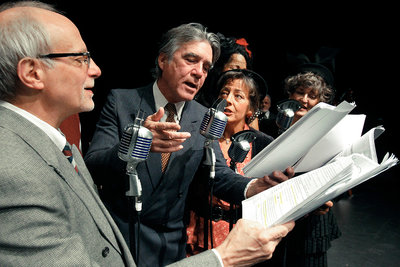
Once upon a time, families across this nation gathered around the radio at the appointed hour, eagerly awaiting the next installment of such classic shows as Gunsmoke, Superman, Burns and Allen or Arch Obler’s creepy Lights Out. This was the “Golden Age of Radio,” an era stretching roughly from the 1930s through the end of the Second World War, and it was no less vital for being cast now in an aura of quaint nostalgia.
Yet there is nothing quaint or dated about old-time radio for Fred Crafts, founder of Radio Redux, a company that stages live readings of classic radio broadcasts. This year, Crafts’ Radio Redux makes the leap from its digs at Springfield’s Wildish Theater into the Hult Center downtown, where it will open its new season Oct. 31 with a production of Arsenic & Old Lace.
With scripts read onstage by real actors costumed in the style of the 1940s, and with on-the-spot sound effects recreated with as much fidelity to the golden age as possible, Radio Redux takes its job seriously, with no winking irony or cute sentiment. According to Crafts, live radio drama is not a curiosity but an art form, albeit one largely unfamiliar to generations raised on television, movies and, now, the internet.
“I think it’s really important,” Crafts says of old-time radio. “It’s an incredible art form and it’s dying. That’s one of the reasons we do it. We don’t do it just to be entertaining; we’re also championing an art form and trying to preserve it. For younger people it’s a brand new experience.”
Radio Redux first came about when Crafts, as president of the Eugene Downtown Rotary, decided to mount a live radio version of A Christmas Carol in 2004. After putting on several holiday shows with minimal rehearsals and an amateur cast, Craft made the leap. “I wondered what would it be like to try to do it in a larger theater, with a more sophisticated cast, so we went to the Wildish Theater in 2009 and began what you would call Radio Redux at that point,” he says.
The move this year to Hult Center, Crafts says, is an opportunity to expand on what Radio Redux can do in terms of audiences and technical finesse. “While it is expensive and it will be a stretch for us to do this, what they offer is very first rate and it’s worth the gamble,” he says. “One thing about the Hult Center, it’s very much a known quantity to people.”
Crafts says he’s hoping a new season in a new venue will bring broader exposure to younger audiences who are unaware of the imaginative powers of dramatized radio broadcasts. “Because people love to use their imagination, we work their imagination and give them a unique experience,” he says. “We tell people to close your eyes and imagine what’s happening. It’s a great experience for people. At the end, it’s just big smiles, you can feel the warmth in the room.”